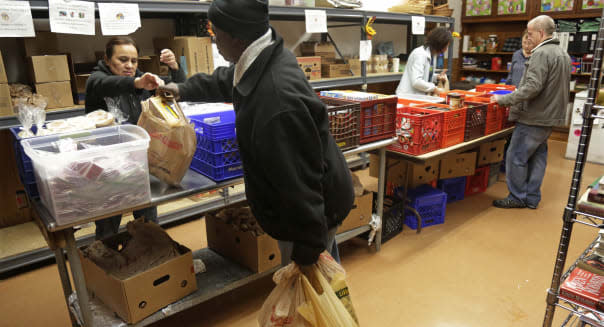Food Stamps Too Skimpy to Improve Food Security or Diet, Study Finds

By Andrew M. Seaman
NEW YORK -- A program that provides food and nutrition assistance to millions of low-income Americans may not be effective at current funding levels, suggests a new study.
Researchers found people who received assistance through the Supplemental Nutrition Assistance Program (SNAP) fared no better than people in similar conditions who were not eligible or didn't enroll in the program.
"Our insights were maybe not surprising, but it's the first time something like this has been documented," Eric Rimm told Reuters Health.
Rimm is the study's senior author and an associate professor of epidemiology and nutrition at the Harvard School of Public Health in Boston.
SNAP -- formerly known as food stamps -- is the largest U.S. food assistance program and reached approximately 45 million people in 2011, Rimm and his colleagues write in the Journal of Nutrition Education and Behavior. The program is run by the U.S. Department of Agriculture (USDA).
People on SNAP can use benefits to buy most food, but not alcohol, supplements or prepared meals.
Previous studies looking into whether SNAP improves people's access to food and diet quality have produced mixed results.
For their study, the researchers recruited 107 adults who called a hunger helpline in Massachusetts and applied for SNAP.
They then compared food access and diet quality among the 64 people who were able to enroll in the program and the 43 people who did not enroll.
They collected questionnaires from those people over three months in 2011.
The researchers found people's access to food -- or "food security" -- improved a bit among both groups. But neither group did particularly better than the other.
%VIRTUAL-article-sponsoredlinks%"It's a really tricky interpretation because obviously people who call the hunger helpline are probably at the absolute highest levels of desperation," Rimm said. "In some ways they don't have any way to go but up."
The quality of participants' diets was measured using a scale that compares what a given person eats to dietary guidelines. The scale has a maximum score of 87.5 and higher scores signify better diet quality.
At the start of the study, the diet quality of participants who ended up enrolling in SNAP was about 23, on average. That compared to a score of about 25 among those who did not enroll.
By the end of the study, the average score among both groups fell to about 22.
The researchers also found that people receiving SNAP benefits increased their consumption of refined grains like breads, pasta and rice by about one serving per day.
Those foods, they write, are linked to a higher risk of diabetes.
"I think what it suggests is in its current form, SNAP assistance that is unstructured food assistance -- giving people money to buy any food item -- at this level does not improve their diets," Anne Barnhill said.
Barnhill was not involved with the new study. She is an assistant professor in the University of Pennsylvania's Department of Medical Ethics and Health Policy at the Perelman School of Medicine in Philadelphia.
She said it could be that restricting people's purchases would nudge them toward healthier foods. Or it's possible healthier foods are more expensive and higher benefits would allow SNAP beneficiaries to buy better foods.
In the study, about 86 percent of participants thought incentives to buy healthier foods and access to more cooking and education classes would help people covered by SNAP eat better.
Also, 59 percent of participants said restricting access to certain foods -- such as soda -- would help them improve their diets.
"They are looking for help," Rimm said.
Barnhill said the study also shows the current funding levels for SNAP are still too low.
"It's not to say they don't help," she told Reuters Health. "It's just that people receiving SNAP assistance still can't afford food."
The maximum amount a person or family can receive in food stamps dropped on November 1 after a temporary increase that was part of the American Recovery and Reinvestment Act of 2009. A single person can now receive a maximum of $189 in benefits per month, down from $200.
Cuts to the program are being debated in the Senate and House of Representatives.
"I think it's time for the USDA to really take this program on and really think about how to make this a really useful resource to guide people toward healthier living," Rimm said.
